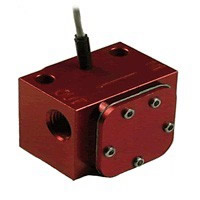Aviation Words: K-factor
From Bits & Pieces Newsletter, February 2015 Issue
There are more than a dozen meanings of “K-factor” out there, but the one that interests pilots is the one used to calibrate aircraft fuel flow meters. The K-factor is a constant, referring to the number of measurable pulses required for a given volume of fuel to pass through the point where flow is being measured. Sensors measuring these pulses send the signal to an onboard chip that converts the pulses into volume, using the K-factor.
Once you have a good measurement of fuel flow, you can keep track of consumption with different engine settings and total consumption over a specific time period. Getting the K-factor right means that you should have an accurate measurement of fuel remaining at all times, but visual checks of fuel levels and then readings from regular gauges should always take priority.
A typical fuel flow transducer
Most engine monitors with fuel flow indication will require the input of a K-factor, and you will find it in the specifications for the fuel flow transducer in use. It is generally a number of thousands of pulses required for a specific volume of fuel being pumped. Since the K-factor is programmable, it can obviously be made more accurate for your specific aircraft based on other measurements of fuel consumption over time, but be very careful not to drop a zero when you enter the new number!
You can learn a lot more about fuel flow testing by reading the FAA Advisory Circular 23-16A guide for certification of aircraft fuel systems.

